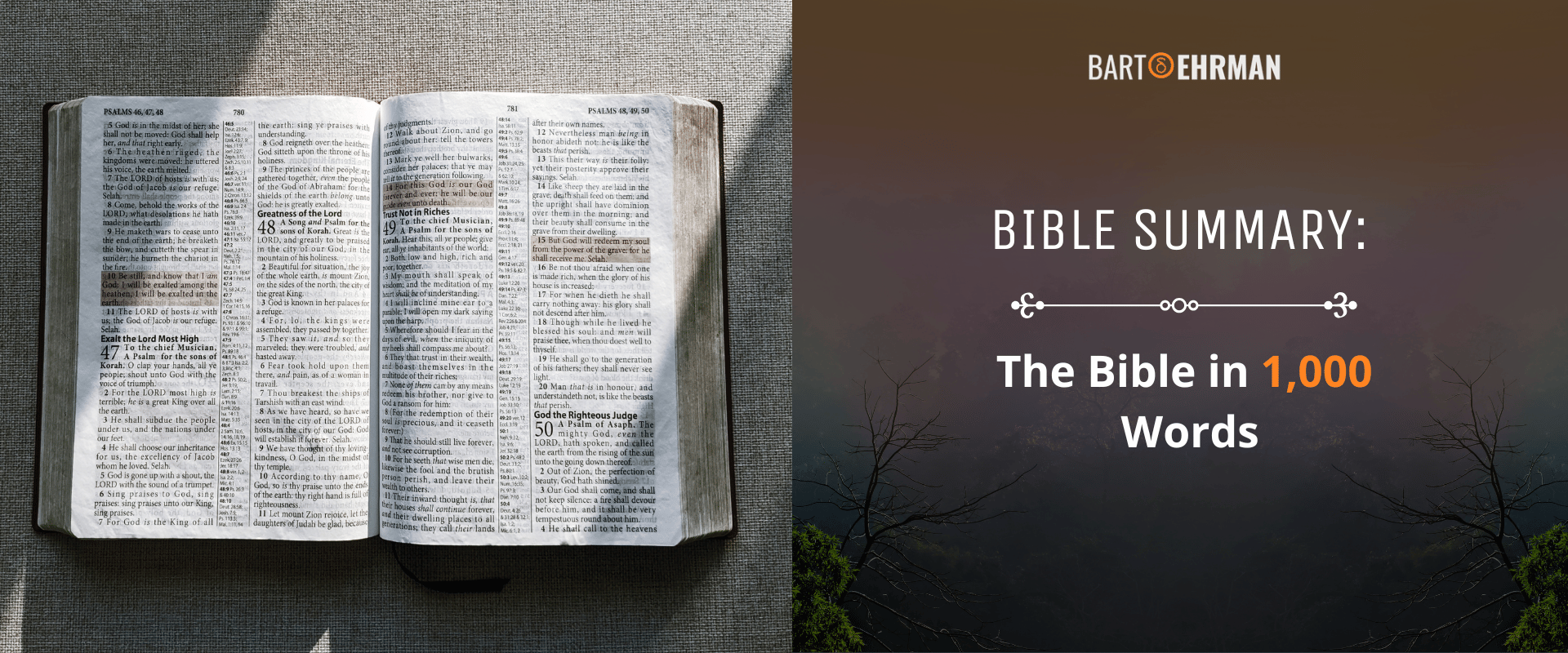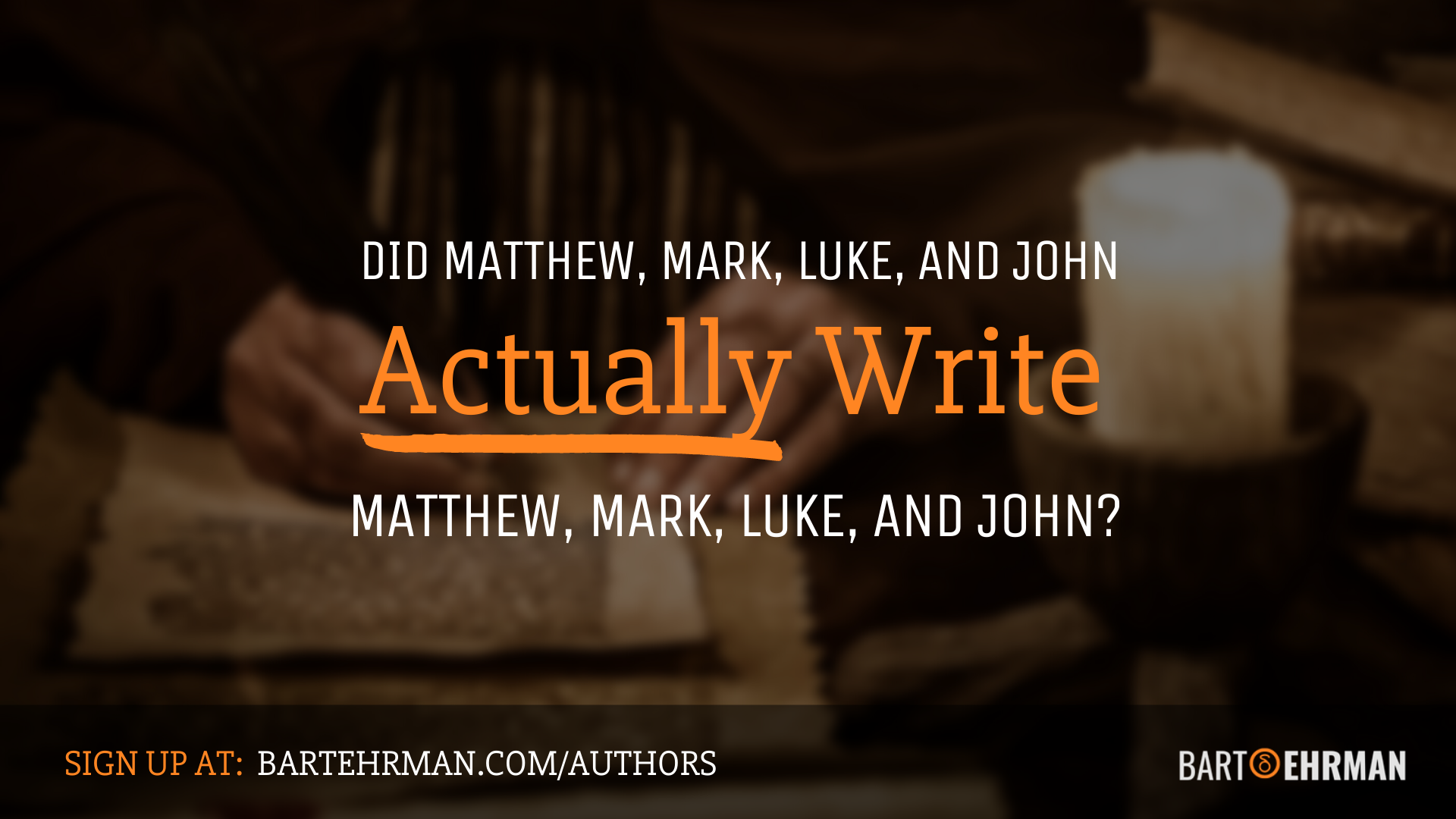Bible Summary: The Bible in 1,000 Words

Written by Joshua Schachterle, Ph.D
Author | Professor | Scholar
Author | Professor | BE Contributor
Verified! See our editorial guidelines
Verified! See our guidelines
Date written: February 7th, 2025
Disclaimer: The views and opinions expressed in this article belong to the author and do not necessarily match my own. - Dr. Bart D. Ehrman
The Bible’s influence stretches across millennia, serving as the foundational Scripture for two of the world’s major religions. However, its complexity and variety can make it challenging to grasp in a concise way.
In this article I’ll offer a synopsis of the Protestant version of the Bible, condensing its vast narrative and teachings into a digestible overview of both the Old and New Testaments. The Bible tells a story of divine interaction with humanity—one that spans centuries, cultures, and genres. In a 1,000-word Bible summary, I’ll explore the key events, themes, and figures that make up this enduring collection of holy texts.

Bible Overview
The Bible is a set of religious texts sacred to Jews (Old Testament only) and Christians (both Old and New Testaments). In fact, though, in The Rise And Fall Of The Bible: The Unexpected History of an Accidental Book, Timothy Beal argues that it’s less a book and more a library, in that it contains many writings written by different people from different historical eras and places. In addition, some Christian denominations have different numbers of books they consider sacred. In this article, though, I’ll be summarizing the Protestant version of the Bible.
(Affiliate Disclaimer: We may earn commissions on products you purchase through this page at no additional cost to you. Thank you for supporting our site!)
The books of the Old Testament, also known as the Hebrew Bible, were originally written in Hebrew, with a small amount in Aramaic. The entire New Testament was written in Koine Greek, an ancient dialect of Greek commonly used in the Hellenistic and Roman periods.
The Protestant Christian Bible consists of 66 books, with 39 books in the Old Testament and 27 in the New. Most of the 66 books were written anonymously, although they are traditionally attributed to well-known biblical figures. The various books of the Old Testament were written by approximately 21 authors between about 1200 and 165 BCE. The New Testament books, on the other hand, were written by 15 or possibly 16 authors between about 50 and 120 CE.
The places where the books of the Bible were written vary widely. The first five books, known as the Pentateuch, were written by Israelites who had returned to Israel after exile in Babylon. The next seven were likely written in Babylon during that exile. Most of the rest of the Old Testament books were written somewhere in Israel.
The New Testament’s authors composed its books in a number of different places within the Roman Empire, although they don’t always make it clear where they are. They include Rome, Syria, and various locations in Asia Minor (modern-day Türkiye).
Having outlined some of the basic facts about the Bible, I’ll now attempt to summarize both the Old and New Testaments (which I’ll henceforth call OT and NT). Remember, though, that the Bible is actually an anthology of various books, so writing a Bible summary by book is a bit like trying to summarize the library.
It’s also important to remember that the books of the Bible are not always in chronological order. Sometimes an event happens in one book that is then predicted in a later one, for example.
Let’s dive into our synopsis of the Bible!
Old Testament Bible Summary
As I noted above, the first five books of the OT are called the Pentateuch. In these books, God creates the world and helps to establish the nation of Israel. The Israelites are later enslaved in Egypt but are liberated by a leader named Moses. Then God gives the Israelites their law or Torah as they wander the wilderness searching for a land God has promised them.
As John Collins notes in A Short Introduction to the Hebrew Bible, the next books narrate a mythicized history of the Israelites after they conquer and establish themselves in their new land. They are defeated, in turn, by other nations until God sends leaders called judges to save them. Later, a couple of widows, Ruth and Naomi come to Israel. Ruth will be the ancestor of Israel’s great King David.
The Israelites then ask God for a king. Their request is granted, but this king, Saul, turns out to be a letdown. After this, God chooses a young man named David to be a highly successful king. Later, when David’s son Solomon is king, there is a time of peace and prosperity that doesn’t last. The kingdom splits into two — one called Judah and the other called Israel. Both kingdoms stop following God, which results in their being conquered and exiled by several other nations.
The Babylonians capture the Israelites and take the elite members back to Babylon as captors, destroying God’s Temple in Jerusalem. When Babylon is conquered by Persia, the Israelites are allowed to return and rebuild the Temple.
After this historical section of the OT, there are several books of poetry. The book of Job is the poetic story of a righteous man to whom God allows various tragedies to happen in order to test his loyalty. The Psalms consist of 150 liturgical hymns attributed to David. Proverbs gives advice for those wanting to be wise, while Ecclesiastes is a (surprisingly negative) meditation on the meaning of life. Finally, the Song of Solomon (or Song of Songs) is an erotic love poem.
The rest of the OT books are prophetic. In Isaiah, God sends the titular prophet to warn Israel of future judgment, and the book of Jeremiah does the same, warning specifically about the Babylonian exile to come. Lamentations, as its title implies, is a series of songs bemoaning Israel’s fate at the hands of the Babylonians.
This theme of a coming divine judgment on Israel is repeated often within the prophetic books. They warn of conquest and exile, plagues of locusts, and all manner of suffering as a result of Israel’s faithlessness to God. Some of the shorter prophetic books also warn that if the Israelites treat each other unjustly, God will punish them. These books also carry God’s promises that if the people are faithful and just, he will reward them.

New Testament Bible Summary
The NT books were written much later than those of the OT and reflect a different historical phase. As Bart Ehrman notes, in The New Testament: A Historical Introduction to the Early Christian Writings, their historical backdrop is the Roman Empire, which had conquered and incorporated Israel. The impetus behind all the NT books is the interpretation of the life, death, and significance of Jesus of Nazareth.
The first four books are called the Gospels, a word which simply means “good news.” Each Gospel is the story of Jesus’ life, death, and resurrection, but there are major differences between some of the details in them. The first Gospel in the NT, Matthew, focuses on Jesus’ role as a new Moses, reinterpreting the Jewish law. The second Gospel, Mark, portrays Jesus as the humble, suffering son adopted by God. Luke views Jesus as a prophet who is rejected by his people, while the last Gospel, John, sees Jesus as a divine being sent from heaven. There is some crossover in these stories — Matthew and Luke used Mark as one of their sources, for example — but the overall portrayals contain major differences, reflecting different ideas about Jesus.
The next book is called the Acts of the Apostles (or just Acts) and tells the story of the early church after Jesus’ death, resurrection, and ascension. It includes Paul, who is a major figure in the NT.
In fact, a number of letters written by Paul come next. There are 13 attributed to him in the NT. However, scholars have known for many years that only seven of them — Romans, Galatians, 1 Thessalonians, 1 and 2 Corinthians, Philippians, and Philemon — were definitely written by Paul. The others were likely written in his name, trading on his authority in the early church.
Six of Paul’s authentic letters are written to Christian communities. He seems to have founded four of them, including those in Corinth, Thessaloniki, Philippi, and Galatia. They address questions and problems those communities are dealing with in Paul’s absence. The letter to Romans is Paul’s self-introduction to an already-established community, assuring them of his sound theology so that they will accept him when he visits them. Philemon, the shortest Pauline letter, is written to one person to advocate for that individual’s runaway slave.
Other letters attributed to Paul, including 2 Thessalonians, 1 and 2 Timothy, Colossians, Ephesians, and Titus, attempt to use Pauline language, but differ from Paul both on points of theology and developments in the church that occurred long after Paul’s death.
Then, there are a number of letters known as the general or Catholic epistles written by others to their own Christian communities. They encourage their people to remain faithful to Jesus despite persecution and warn them about false teachers.
The final book in this Bible summary of the NT is called Revelation. It concerns the apocalyptic visions of a Christian named John, who warns that those who persecute Christians in his time will receive divine punishment, while those who remain faithful will be rewarded.
Conclusion
The Bible has been Christians’ authoritative text for centuries. The Old Testament or Hebrew Bible has held that position for Jews for even longer. Although the various books were eventually collected, collated, and canonized into one large unit, it remains a library of diverse texts from different times and places and even espouses many conflicting ideas. Despite this, many believe the entire Bible has the sanction of divine authority.
Its 66 books were written and edited over a long period. The Old Testament was written between 1200 and 165 BCE, although it wasn’t entirely canonized within Judaism until at least the end of the 1st century CE. The New Testament was written between 50 and 120 CE and canonized around the 4th century CE by Christians, although Catholics, Protestants, and Orthodox Christians still differ about which books can be defined as sacred Scripture.
FREE COURSE!
WHY I AM NOT A CHRISTIAN
Raw, honest, and enlightening. Bart's story of why he deconverted from the Christian faith.
Over 6,000 enrolled!

